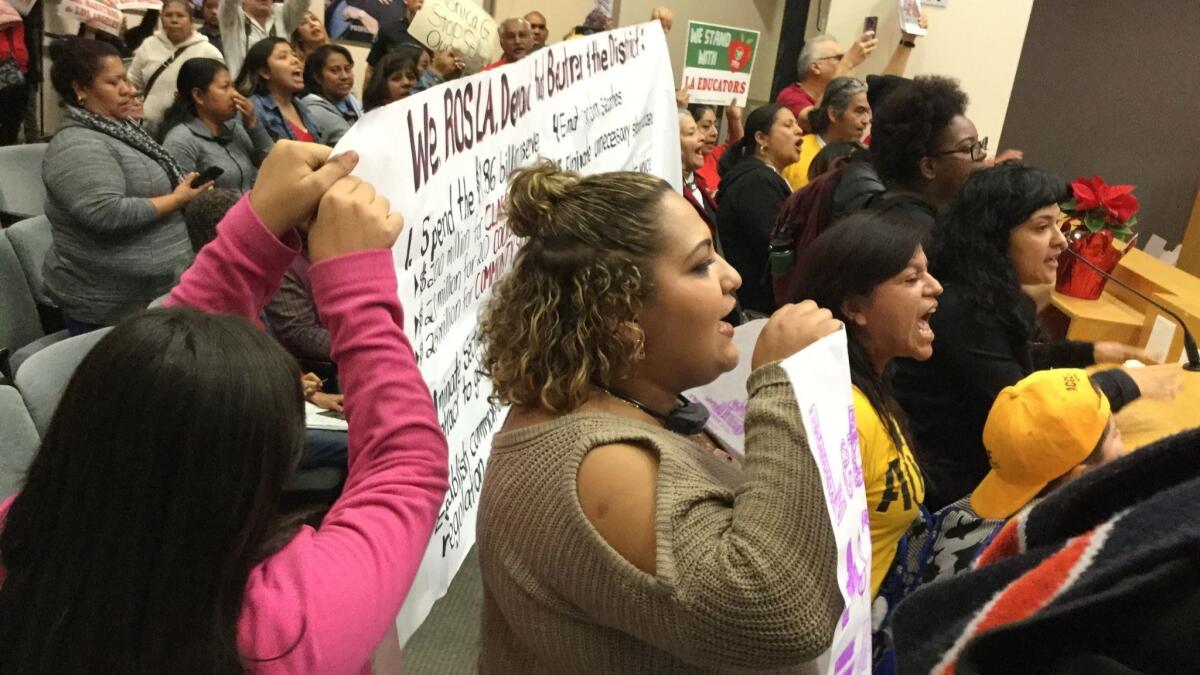Protesters shut down Los Angeles Board of Education meeting

- Share via
School district officials are busy “reimagining” the nation’s second-largest school system, but what happened Tuesday was not exactly what they had in mind.
A group of at least 50 protesters shut down the Los Angeles Board of Education meeting early — just before a debate that was expected to get a little testy on its own.
These days, two major possibilities color just about everything in Los Angeles Unified — the growing prospect of a teachers strike and Supt. Austin Beutner’s still largely confidential plan for a massive district reorganization.
The major theme of the protest, organized by teachers union allies, was support for the teachers, though student demands also were a part of it.
“The more involved I become, the more I become aware of what is happening and the things that are not happening,” said Ruby Gordillo, who was accompanied by her daughter Alandra, a fifth-grader at 10th Street Elementary in Pico-Union. “Our schools are very misleading in the way they answer questions. They give us answers in a way that makes me believe they don’t have interest in our community.”
District officials and the teachers union have been in negotiations for more than 18 months, and a January strike appears increasingly likely. The two sides are nearly done with fact-finding, the final step of a negotiation process set out under state law.
The draft of a report from a fact-finding panel is expected on Friday. A final version will be made public about 10 days later, if it isn’t leaked sooner. After that, the school district could impose a contract and the union leadership could call a strike.
Friday is the last day of school before winter recess. Classes are scheduled to resume Jan. 7.
The protesters echoed the contention of United Teachers Los Angeles that the district — whose general fund budget this year is about $7.5 billion — is hoarding a massive reserve that could be used to pay teachers more and improve conditions for students. They point to last year’s ending balance of nearly $2 billion.
“I just don’t believe the numbers,” Gordillo said. “Honestly, it’s crazy.”
A senior at King/Drew Magnet High School of Medicine and Science, who identified herself only as Cheyanne because she said she felt at risk for speaking out, talked of the need for smaller class sizes and better staffing. She said she’d had 52 students in her 10th-grade chemistry lab.
Protesters testified assertively but in an orderly way before things got out of hand around 4:15 p.m., about three hours into a meeting that covered a broad range of topics.
Some of the chants took aim at Beutner, who took the district job last May after a career as a successful businessman and philanthropist: “Austin Beutner, you can’t hide! We can see your greedy side!”
The audio for the live broadcast on the district’s television station quickly went mute, turning on again in spurts only when board President Monica Garcia spoke to try to calm the demonstrators.
Garcia gave up after several minutes and adjourned the meeting. She and Beutner, who had watched quietly, left the room. Some board members remained behind, waiting out the chants, which went on for about 30 minutes. A few protesters talked calmly with board members after; others took part in an impromptu rally near a street corner outside.
Earlier in the meeting, district officials had made their case for frugality during a budget presentation by Chief Financial Officer Scott Price. He said that about $500 million of money left over last year is committed to cover the 6% raises that the district is willing to give teachers and has already agreed to for most other employees.
Another $400 million already is committed to schools and programs, he said. In an earlier interview, he said that that money could be pulled back, but only with great disruption for students and employees.
About $700 million is uncommitted but will disappear within three years because the district is spending much more than it is taking in, Price said.
Teachers and others contend that the district should push harder for tax measures and increased state funding. That was a debate school board members had intended to take up Tuesday.
Board members would have discussed two competing proposals for coming up with revenue: one put forward by two Beutner allies, another by two board members who have been more critical and who raised concerns about Beutner’s plan, which this week began to get at least a partial public vetting.
On Monday, Deputy Supt. Vivian Ekchian hosted a forum on “Reimagining L.A. Unified” at White Middle School in Carson. Her presentation — to a packed crowd of more than 500 — raised more questions than it answered.
The plan envisions dividing the school system into about 32 networks — which was known — but Ekchian said that six larger administrative regions would continue to exist.
One goal, she said, would be to let schools — rather than the district’s personnel department — do their own hiring. She also suggested that schools could have the power to consolidate duties by combining or rethinking non-teaching jobs.
Ekchian said an important goal was to gather feedback. She said the reorganization, if it worked, could make the district more efficient and effective.
Clinton Frosch, a parent, was not persuaded.
“They talk about streamlining, but spreading things out is usually not streamlining,” Frosch said. “They talk about cutting double jobs but how are you going to do that if you have 32 districts versus six or eight or four?”
Twitter: @howardblume
More to Read
Sign up for Essential California
The most important California stories and recommendations in your inbox every morning.
You may occasionally receive promotional content from the Los Angeles Times.











